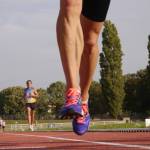During sports we often take our feet for granted, but whether you’re a professional sportsperson or an aspiring Sunday League footballer, a healthy pair of feet are your best friend. Treat them properly and your feet will give you a lifetime of fun filled sport and pain free workout. To ward off foot menaces like athletes foot, blisters, corns and verrucae and many other foot conditions and diseases, the following precautions should stand you in good stead.
1. Always use the correct shoe for the correct sport, as the wrong shoes can lead to injury. These days, there is virtually a type of shoe for every sport but all of them have certain characteristics to cushion your feet: cushioning for shock absorption and a firm heel counter for stability. Some will also have ankle support, for sports involving many changes of direction. Always seek expert opinion.
2. Make sure the shoe fits properly. Many people actually wear shoes that are too small for them. The rule of thumb is that there should be one thumb’s breadth between the end of your longest toe and the end of your shoe.
3. Secure your laces. It may be fashionable to leave the laces undone, but this means the foot is not supported properly and may cause injury.
4. Make sure that where the shoe bends coincides with where your foot bends. This should be around the ball of your foot, where your toes meet the foot.
5. Always wear good quality, well-fitting cotton socks. Tight socks can be as bad as tight shoes.
6. Try not to wear your sports socks and trainers everyday. Our feet sweat naturally, like the rest of the body during exercise and this is absorbed into the sock and trainer. It takes longer than overnight for this moisture to dry out, so try to alternate shoes and wear clean socks daily.
7. If your feet are particularly sweaty, special absorbent insoles or the application of surgical spirit may help. Alternatively if your feet are particularly dry, using an emollient or foot cream may help.
8. If you are prone to blisters make sure that the inside of your shoe fits correctly, is not worn, and your feet are not sweaty. Alternatively, try wearing two pairs of socks with the pair nearest your feet made from thin cotton. This reduces the friction.
9. Finally, remember that our feet and legs need training and looking after. Always allow enough time to warm up and warm down before and after exercise. Do not attempt to do too much too soon as your feet and legs will get tired and be predisposed to injury. Try not to perform the same type of exercise every day.
Your feet are perfectly designed for sporting activity, but the demands placed on them are heavy. For each mile you run, your feet will hit the ground about 1,500 times and with each step, your foot will absorb a force several times your body weight. An 11 stone man of average size will process 112 tonnes of weight through each limb per mile. Feet can and do fall prey to injury and disease, so the pounding of the pavement, the discomfort of badly fitting shoes or the germs of communal changing rooms are all threats to your foot well-being.

